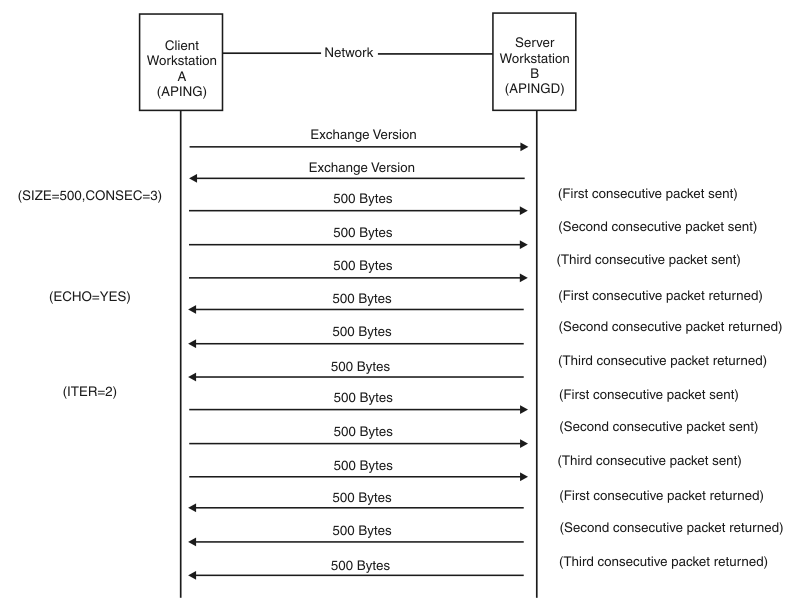 z/OS Communications Server: SNA Network Implementation Guide
z/OS Communications Server: SNA Network Implementation Guide
 z/OS Communications Server: SNA Network Implementation Guide
z/OS Communications Server: SNA Network Implementation Guide
|
Previous topic |
Next topic |
Contents |
Contact z/OS |
Library |
PDF
APING support z/OS Communications Server: SNA Network Implementation Guide SC27-3672-01 |
|
|
APING support provides the ability to test for connectivity between LU 6.2 resources, and to display pertinent routing and performance information. APING support consists of two transaction programs, APING and APINGD. The APING transaction program represents the client side of a transaction, while the APINGD transaction program represents the server side of a transaction. When a conversation is established, the client transaction program sends packets of data to the server transaction program. When the client is finished, it indicates to the server transaction program either to send the data back to the client or to send a confirmation back to the client indicating that the data has been received. The client continues the transaction until complete. The VTAM® APING transaction program is started when a DISPLAY APING command is issued. The APINGD transaction program is started when another system in the network attempts to verify its connectivity and performance with VTAM using the APING transaction program. Using the DISPLAY APING command, the network operator can do the
following things:
When you issue a DISPLAY APING command, the following operands
determine the amount of data that is sent by the client transaction
program to the server transaction program:
For example, if you issue the command D NET,APING,ID=dluname,CONSEC=3,ECHO=YES,ITER=2,SIZE=500, as shown in Figure 1, three consecutive packets of 500 bytes are sent to the server transaction program two times, and the server transaction program returns three packets of 500 bytes two times. Figure 1. Example of flows between client and server
for DISPLAY APING command
 Guideline: The maximum value for CONSEC,
ITER, and SIZE is 32763. By coding 32763 for each of these operands
with ECHO=YES, 32763 packets of 32763 bytes of data are sent to the
partner transaction program 32763 times and the partner transaction
program returns 32763 packets of 32763 bytes of data 32763 times.
This could cause a significant impact to the performance of your network.
The number of concurrent APING or APINGD transaction program instances allowed can be displayed with the DISPLAY APINGTP and DISPLAY APINGDTP operator commands, and can be adjusted using the MODIFY APINGTP and MODIFY APINGDTP commands. The default instance limit for the APING and APINGD transaction programs is 10. If you need to cancel APING transaction processing, see Canceling APING sessions. The command verification exit, ISTCMMND, can be used to restrict the operands specified on the DISPLAY APING command. 


|
 Copyright IBM Corporation 1990, 2014 Copyright IBM Corporation 1990, 2014 |